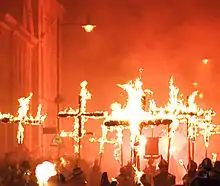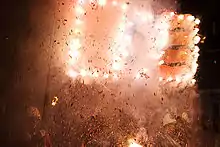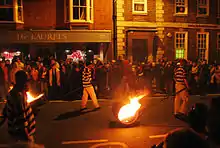Lewes Bonfire
Lewes Bonfire or Bonfire, for short, describes a set of celebrations held in the town of Lewes, Sussex that constitute the United Kingdom's largest and most famous Bonfire Night festivities,[1] with Lewes being called the bonfire capital of the world.[2]


Always held on 5 November (unless the 5th falls on a Sunday,[3] in which case it's held on Saturday 4th), the event not only marks Guy Fawkes Night – the date of the uncovering of the Gunpowder Plot in 1605 – but also commemorates the memory of the seventeen Protestant martyrs from the town burned at the stake for their faith during the Marian Persecutions.
Lewes is home to the largest and most celebrated of the festivities in the Sussex bonfire tradition. There are seven societies putting on six separate processions and firework displays throughout Lewes on 5 November. As well as this, 25–30 societies from all around Sussex come to Lewes on the fifth to march the streets. This can mean up to 5,000 people taking part in the celebrations, and up to 80,000 spectators attending in the county market town with a population of just over 17,000.[4][5]
History
The history of bonfire celebrations on 5 November throughout the United Kingdom have their origins with the Gunpowder Plot of 1605, where a group of English Catholics, including the now infamous Guy Fawkes, were foiled in their plot to blow up the House of Lords.
The following January, an act entitled 'An Acte for a publique Thanksgiving to Almighty God ever year of the Fifth day of November' was passed, which held that 5 November should be held in perpetual remembrance of the plot, with a special service held in every Church of England parish church.[6]
Celebrations in Lewes were not planned or carried out annually, but were more random events that more closely resembled riots. They continued until they were banned by Oliver Cromwell during the Commonwealth. However, they were reintroduced when King Charles II returned, but still on a random basis. Interest waned by the end of the 18th century but in the 1820s large groups of Bonfire Boys started celebrating with fireworks and large bonfires. The celebrations became rowdier and rowdier until 1847, when police forces were drafted in from London to sort out the Bonfire Boys. There were riots and fighting, and restrictions were clamped down on the celebrators, their locations moved to Wallands Park, at that time fields, not the suburb it is today. However, in 1850 they were allowed back to the High Streets. By this time the former riots had become much more like the processions carried out today. In 1853 the first two societies, Cliffe and Lewes Borough were founded, and most of the others were founded later in the same century. The cult of the Sussex martyrs was instigated at a time of the restoration of the Catholic hierarchy in England, bolstered by an increase in the Irish Catholic population, as well as the high-profile conversion to Catholicism of members of the Oxford movement, including Cardinal Newman and former Archdeacon of Chichester, Henry Edward Manning. In the mid 19th century the practice of burning an effigy of Pope Paul V at the Lewes Bonfire celebrations began. Paul V was a peaceable man who happened to be pope at the time of the Gunpowder Plot in 1605 and who cannot be held responsible for the Gunpowder Plot or the persecution of Protestants in the reign of Mary I, which were linked at this time by a misunderstanding of the past.[7] In 1893 William Richardson, rector of the Southover district of Lewes, held sermons on the Sunday before 5 November warning about the perils of Catholicism. Many attendees were members of the newly-formed Orange Lodge in Lewes.[8]
There is a history of religious antagonism and anti-popery around the bonfire celebrations in Lewes.[9] In the 1930s the mayor of Lewes requested that 'no popery' banners be removed and an end to the burning of effigies of Pope Paul V.[10] In the 1950s the Cliffe Bonfire Society was banned from the Bonfire Council from taking part in the United Grand Procession for its refusal to stop carrying a 'no popery' banner and banners commemorating the 16th century Protestant martyrs burned at Lewes.[11] In 1981 Ian Paisley visited Lewes on Bonfire Night and tried to fan the flames of conflict by handing out anti-Catholic pamphlets. His intervention back-fired and the following year he was burned in effigy.[12] Today, anti-Catholic attitudes are rare and the militant Calvinism that continues in Northern Ireland is all but extinct in Lewes.[13] In the 21st century, controversy continues to be associated around the Bonfire societies and competing definitions of tradition and bigotry.[14] For instance, the burning in effigy of Pope Paul V was described in 2012 as "a scandalous piece of stone-cold bigotry"[15] In 2017 the Lewes Borough Bonfire Society agreed to end the tradition of blacking-up and wearing skulls and horns as part of its Zulu costumes.[16]
Event
To mark the demise of the 17 Lewes Martyrs, 17 burning crosses are carried through the town, and a wreath-laying ceremony occurs at the War Memorial in the centre of town. Ladies' and men's races take place, pulling flaming tar barrels in a "barrel run", which takes place along Cliffe High Street at the start of the evening. A flaming tar barrel is then thrown into the River Ouse; this is said to symbolise the throwing of the magistrates into the river after they read the Riot Act to the bonfire boys in 1847. The festivities culminate in five separate bonfire displays.
A number of large effigies are drawn through the streets before being burned at the bonfires. Each year these include Guy Fawkes, as well as Pope Paul V,[17] who became head of the Roman Catholic Church in 1605. In addition, each of the five main local societies creates a topical "tableau"(a large three-dimensional model packed with fireworks), and the Cliffe and Southover societies display on pikes the heads (also in effigy) of its current "Enemies of Bonfire", who range from nationally reviled figures to local officials who have attempted to place restrictions on the event. In 2001 effigies of Osama bin Laden were burned by the Cliffe, Commercial Square and Lewes Borough bonfire societies,[18] causing the Lewes Bonfire to receive more press attention than usual, being featured on the front page of some national newspapers, as did the Firle Bonfire Society's 2003 choice of a gypsy caravan.[19] In 2014 police investigated complaints about plans to burn two effigies of Alex Salmond, the First Minister of Scotland, and one model was subsequently withdrawn from the event.[20] In 2015 effigies of David Cameron with a pig, Jeremy Clarkson and Sepp Blatter were burned.[21]
The Daily Telegraph has described the night as "a head-on collision of Halloween and Mardi Gras".[22] Up to 80,000 people have been known to attend this local spectacle, coming from all over the South and sometimes further afield. As the event has grown in recent years, the police presence on the night has increased to deal with the large crowds attracted to the event. The events are organised by each of the local bonfire societies in conjunction with Sussex Police, Surrey Police and East Sussex Fire & Rescue Service, SE Ambulance Service and St John Ambulance has treatment centres and ambulances around procession routes and bonfire sites to care for anyone who has been injured. In recent years, railway stations at Lewes, Falmer, Glynde and Southease have had planned closures for the duration of the event due to foreseeable overcrowding.[23]
Bonfire societies
Lewes has seven bonfire societies, whereas othertowns and villages in Sussex have a single bonfire society each, even large ones like Eastbourne. These other societies hold their own bonfire celebrations in the weeks leading up to November the Fifth, and each of the Lewes societies sends out parties to these "outmeetings" or "outfires" (the nomenclature varies between the societies) to march with the local society. On the Fifth, the Lewes societies process separately around their own particular areas before all except the Cliffe and South Street join together in Western Road to parade down St. Anne's Street, the High Street and School Hill, followed by the societies from elsewhere in Sussex. After several processions, including acts of Remembrance for the war dead, each society marches to its own fire site on the edge of the town, where there is a large bonfire and firework display, and effigies are burned. The societies then return to their headquarters for Bonfire Prayers. Whilst marching nearly all members carry torches, some ignite and drop bangers (locally called "rookies", short for rook scarers),[24] and some carry burning crosses, banners, musical instruments or burning letters spelling out the initials of the society. Many of those processing wear "smuggler uniforms" (striped jumpers, white trousers, black boots and optional red hats), with each society having a different coloured jumper. Members have to make or buy their own costumes. Torch-making is a time-consuming process and begins in September, with many society members joining in.
Cliffe
The Cliffe, founded in 1853, traditionally represents the Cliffe and Lansdown areas of Lewes (centred around Cliffe High Street), but recently they've also claimed the South Malling suburb with the addition of the "Malling Bonfire Society". Their smugglers' jumpers are black and white, and the pioneer fronts are Vikings and French Revolutionaries. The Dorset Arms is the society's headquarters, and the local church is St. Thomas à Becket's.[25] Currently the only society to march under a "No Popery" banner and to continue in the tradition to "burn" (more accurately explode with fireworks)[26] an effigy of Pope Paul V at Bonfire.[27]
Commercial Square
Founded in 1855, they represent the St. John's area north of Lewes Castle, based on Commercial Square, which is where their headquarters, the Elephant and Castle pub, is based. The pioneers are Native Americans (this theme was picked after Lewesians visited the US in the 19th century and realised their hardships) and American Civil War soldiers, and the smugglers wear gold and black jumpers. The society also claims the Wallands Park and Landport suburbs. The local church is St John sub Castro.[28]
Lewes Borough
Lewes Borough is the joint oldest society with Cliffe, formed in 1853. Until 1859 they were known as the 'Lewes Bonfire Society' and have been marching the streets of the town for over 150 years. Borough is the 'home' of the Zulu which is their First Pioneer Group and the Tudor which is the Society's Second Pioneer Group. Their jumpers are blue and white. In 1863 the famous Monster Iron Key of the Ancient Borough of Lewes weighing nearly a quarter hundredweight,(over 12 kilos) was carried in the procession for the first time. The same key is still carried today in the Borough's processions and is a symbol that on 5 November the 'Borough Boys' are given the freedom of the streets of Lewes. Representing the western half of Lewes and located on Western Road, their headquarters is St. Mary's Social Club, which unlike the others, is not a pub. The local church is St. Anne's.[29]
Southover
Southover has roots in the mid-19th century but it disbanded in 1985, and then reformed in 2005. It represents the Cranedown and St. Pancras areas as well as the old village of Southover. Located on Southover High Street, the local church is St. John the Baptist's, where there is a war memorial, and the headquarters is the King's Head. Their guernseys are red and black and their pioneers are monks (representing the remains of the Priory of St. Pancras nearby) and buccaneers. Southover march with the British Imperial Marching Band, the Pentacle Drummers, and either Pandemonium or Earthquake drumming bands. Banners carried include a large Tudor rose (to represent Anne of Cleves' House on Southover High Street) and a banner bearing a picture of William of Orange landing at Brixham in southwest England on 5 November 1688.[30] Southover's firesite is at the Convent Field, behind Lewes Football Club. Southover has a particular affinity with Remembrance, and holds a service at its own war memorial as well as one at the main town war memorial.
South Street
South Street was formed in 1913 as a society for the children of members of the Cliffe; however, both Cliffe and South Street now accept members of all ages. Their jumpers are brown and cream, and their pioneers are (first) Colonial Period (mid-18th century) and (second) English Civil War (mid-17th century) soldiers. They are based on South Street and the small area to the west between it and the River Ouse, and their headquarters is The Snowdrop, South Street. Their firesite is on the Railway Land.[31]
Waterloo
Waterloo was reformed in 1954[32] and represents the area just to the east of the main Commercial Square part (there is a fair bit of overlap between the two) based on Market Street, a quarter of Lewes with little population as it was heavily destroyed by the local planning council to make way for roads. Waterloo's jumpers are red and white and their pioneers are Mongols and Ancient Greeks and Romans. Their headquarters is the Lamb Inn.[33]
Nevill Juvenile
Founded in 1967 specifically for children, Nevill has remained a juvenile society and represents the Nevill Estate. Their headquarters is St. Mary's Social Centre. They hold their celebrations a week or two before the other societies with help from those six. Their pioneers are Valencians, Medieval, and British Military (1900–1950),[34] and their jumpers are green and white.[35]
See also
Bibliography
References
- Times Writers (5 November 2009). "Tonight's the night: bonfires and fireworks". Times. London.
- Jones, Lucy (2 November 2010). "Unusual places to go and watch fireworks". The Daily Telegraph. London.
They don't call Lewes the Bonfire capital of the world for nothing.
- "The Lewes Societies". Lewes Bonfire Council. Retrieved 6 November 2010.
- Hanna, Nick (8 October 2005). "Flaming passions". Daily Telegraph. London. Retrieved 6 November 2010.
- "Census 2001: Parish Headcounts: Lewes". Office for National Statistics. Retrieved 3 November 2009.
- "History of Bonfire". Cliffe Bonfire Society.
- Goring 2003, p. 157.
- Goring 2003, p. 130
- Flint & Kelly 2013, p. 89.
- Flint & Kelly 2013, p. 89.
- Flint & Kelly 2013, p. 89.
- Goring 2003, p. 157.
- Goring 2003, p. 157.
- Flint & Kelly 2013, p. 89.
- Meagher, Kevin (5 November 2012). "Bonfire Nightbigotry is alive and well in Lewes". Left Foot Forward. Retrieved 5 June 2017.
- Booth, Robert (5 November 2017). "Lewes bonfire society ends tradition of blacking-up". The Guardian. Retrieved 14 November 2017.
- "Cliffe Bonfire Society web site". Cliffebonfire.com. 21 October 2010. Retrieved 8 November 2010.
- "Sussex Express Report 2001 – Lewes Bonfire Night Celebrations". Lewes Bonfire Celebrations.
Cliffe had him sitting on a lavatory in their main tableau. Borough produced him in effigy and Commercial Square displayed him in the 'flesh', walking in front of a hissing crowd in the united procession.
- Helm, Toby (15 November 2003). "How tradition lit the fuse for gipsy effigy". The Daily Telegraph. London.
- "Police investigate Alex Salmond bonfire effigy". BBC News. 6 November 2014. Retrieved 6 November 2014.
- https://www.mirror.co.uk/news/uk-news/lewes-bonfire-naked-david-cameron-6777404
- "Ten Guy Fawkes celebrations". Daily Telegraph. London. 1 November 2008.
- "Lewes bonfire travel information". Lewes and Eastbourne Councils. 24 September 2018. Retrieved 24 September 2018.
- "Portek Ltd Banger Ropes". Retrieved 10 December 2011.
- "The Member Societies: Cliffe Bonfire Society". Lewes Bonfire Council. 30 October 2006. Retrieved 18 June 2009.
- O'Dea, Sharon. "Burning the Pope". flickr.
- "Lewes Bonfire Night guide: What time do the processions and fireworks start and what is the history of the event?". Crawley News. Retrieved 15 April 2015.
Cliffe Bonfire Society still marches under the No Popery banner and they also burn the Pope. Not the current Pope, though, the Pope in 1605 – Paul V.
- "The Member Societies: Commercial Square Bonfire Society". Lewes Bonfire Council. 30 October 2006. Retrieved 18 June 2009.
- "The Member Societies: Lewes Borough Bonfire Society". Lewes Bonfire Council. 2 June 2009. Retrieved 18 June 2009.
- "The Member Societies: Southover Bonfire Society". Lewes Bonfire Council. 22 October 2008. Retrieved 18 June 2009.
- "The Member Societies: South Street Bonfire Society". Lewes Bonfire Council. 30 October 2006. Retrieved 18 June 2009.
- "The Member Societies: Waterloo Bonfire Society".
- "The Member Societies: Waterloo Bonfire Society". Lewes Bonfire Council. 16 October 2008. Retrieved 18 June 2009.
- "Nevill Juvenile Bonfire Society". Njbs.co.uk. Retrieved 11 November 2013.
- "The Member Societies: Nevill Juvenile Bonfire Society". Lewes Bonfire Council. 30 October 2006. Retrieved 18 June 2009.
External links
 Media related to Lewes Bonfire at Wikimedia Commons
Media related to Lewes Bonfire at Wikimedia Commons
